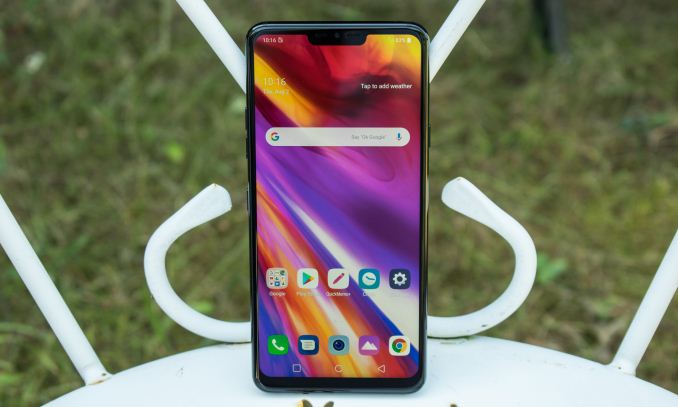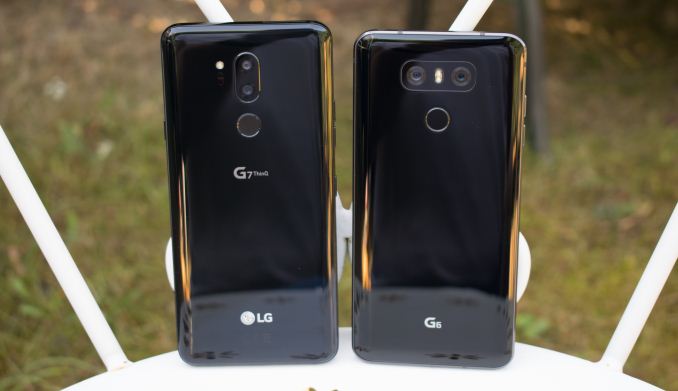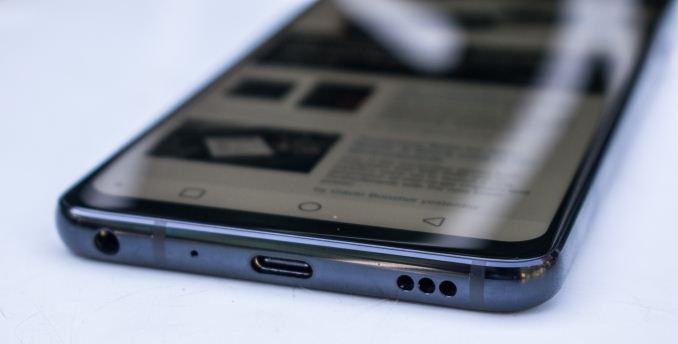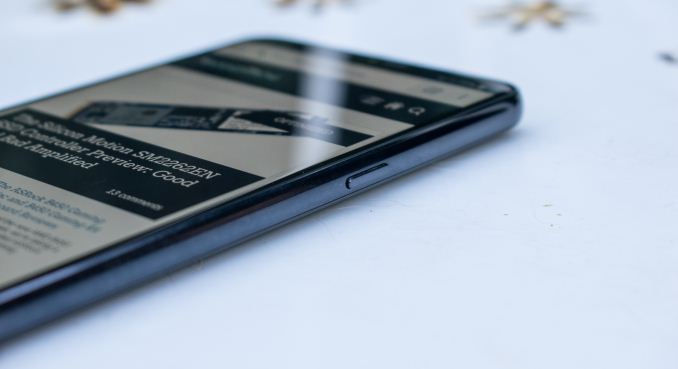The LG G7 Review: A Rushed Attempt?
by Andrei Frumusanu on August 9, 2018 11:00 AM EST- Posted in
- Smartphones
- LG
- Mobile
- LG G7 ThinQ
- LG G7

This year was a change in pace for LG. The company's "mainline" flagship device, the LG G7, was released a couple of months later later than in years prior, hitting the market in the early summer rather than the more traditional spring.
And while this may sound like a trivial distinction, it's actually more meaningful than it may first appear. The tight schedules in the smartphone industry mean that time is often the most valuable asset a manufacturer can have. In this case, scheduling the G7 for a bit later in the year gave LG an opportunity to try to raise its build-quality and to offer a well-rounded smartphone, in order to produce a more viable competitor to the fierce competition that are the other flagship handsets.
The biggest impact of this shift comes in the form of the SoC – the heart of the phone. Unlike last year's LG G6, where LG opted to use a prior generation SoC, for this year, the G7 avoids such a compromise. Instead LG is packing the phone with the latest internals, and at least on paper, it looks to be a competitive offering for 2018.
LG’s been in a relatively rough spot in the last couple of years, as we’ve seen the company stumble in terms of product execution. The LG G4 suffered from performance and battery issues due the Snapdragon 808/810 issues for that generation. The G5 promised great innovation through its modular design, however this again didn’t exactly pan out in terms of commercial success, mostly due to the phone’s weaknesses such as the display as well as a compromise in build quality due to the modular design.
The G6 overall was probably LG’s most solid phone over the last few years and it didn’t have any deal-breaking issues, other than it being a S821 device in a year of S835 alternatives. 2017 has been probably the year where the V-series actually seemingly has outshined the G-series as LG’s top-tier flagship line.
The V30 has been an excellent device, however I’ve been abstaining recommendations of phone due to the fact that my review unit had really bad uniformity issues, as well as bad low-brightness picture quality on the display. Newer units we've been sampled have offered better uniformity, but both were still not quite as perfect as you'd find from Samsung alternatives. Least to say, having to play the display lottery is not something that should be happening at these price-points.
The G7 promises a lot in terms of specifications, but most importantly for LG, what the phone needs to deliver is an increase in the overall product quality as well as more attention to detail.
| LG ThinQ G7 | ||
| LG G7 | LG G6 | |
| SoC | Qualcomm Snapdragon 845 4x Kryo 385 Performance @ 2.8GHz 4x Kryo 385 Efficiency @ 1.77GHz Adreno 630 @ 710MHz |
Qualcomm Snapdragon 820 2x Kryo @ 2.34GHz 2x Kryo @ 2.19GHz Adreno 530 @ 653MHz |
| Display | 6.09-inch 3120x1440 (19.5:9) IPS LCD |
5.7-inch 2880x1440 (18:9) IPS LCD |
| Dimensions | 153.2 x 71.9 x 7.9 mm 162 grams |
148.9 x 71.9 x 7.9 mm 163 grams |
| RAM | 4GB LPDDR4x | |
| NAND | 64GB UFS 2.1 + microSD |
32/64GB UFS + microSD |
| Battery | 3000 mAh (11.55 Wh) non-replaceable |
3300 mAh (12.54 Wh) non-replaceable |
| Front Camera | 8MP medium angle (90°) | 5MP, f/2.2, wide-angle (100°) |
| Primary Rear Camera | 16MP Sony IMX351 1/3.09" 1µm pixels, narrow angle (70°) F/1.6 lens w/OIS |
13MP, Sony IMX258, narrow angle (71°) 1.12µm pixels, F/1.8 lens w/OIS |
| Secondary Rear Camera | 16MP Sony IMX351 1/3.09" 1µm pixels, wide angle (107°) F/1.9 lens |
13MP, Sony IMX258, wide-angle (125°) 1.12µm pixels, F/2.4 lens |
| SIM Size | NanoSIM | |
| Wireless | 802.11a/b/g/n/ac 2x2 MU-MIMO, BT 5.0 LE, NFC, GPS/Glonass/Galileo/BDS |
|
| Connectivity | USB Type-C, 3.5mm headset | |
| Features | Fingerprint reader, display notch, high resonancy speaker, AI assistant button, IP68 rating |
Fingerprint reader |
| Launch OS | Android 8.0 | Android 7.1 with LG UX 6.0 |
In terms of the hardware, the G7 is a large upgrade over the G6 as it represents a two-generation jump in the SoC, switching from the Snapdragon 821 to a Snapdragon 845. Performance wise we should see excellent results from the G7, as most other Snapdragon 845 devices this year have just been fantastic products.
The phone comes with 4GB of main memory as well as 64GB of UFS 2.1 storage, with the option of a microSD slot for expandable storage.
In terms of device footprint, LG actually managed to match the width and thickness of the G6 – although the industrial design has changed. The new G7 ergonomically feels like a smaller phone thanks to its more rounded edges. Where the G7 differs from the G6 in terms of dimensions is the height: it adds 4.3mm on to the top of the phone. The new format houses a longer 19.5:9 aspect-ratio screen which comes with a top display notch. Although the device is longer, its top and bottom bezels have seen a reduction compared to the G6 so the overall display-to-body ratio has increased.
A non-visible change in terms of the internals is that the battery size has actually decreased from 3300mAh down to 3000mAh – it’s possible that LG had to do this to be able to integrate the new speaker design. Overall though this doesn’t concern me too much as the efficient SoC and promised screen efficiency should still result in good battery life.
The display saw a lot of fanfare as the 3120x1440 resolution unit is of a new RGBW "M+" subpixel layout technology which promises great strides in terms of display power and power efficiency.
The back of the phone we continue to see a glass cover, and it comes with all the usually associated advantages, such as wireless charging and an IP68 rating. The camera housing has seen a redesign as the horizontal dual-camera layout in the G6 and V30 has been replaced for a smaller and tighter vertical setup.
The G7’s camera hardware hasn’t changed much from the V30’s – the main camera is still a 1/3.09" 16MP Sony IMX351 with 1µm pixels and a lens with a large f/1.6 aperture.
The wide-angle module however has seen larger changes as it sees a resolution bump from though a sensor upgrade, this time around using the same sensor as the main camera. Also notable is that the wide-angle view has been reduced from 120° down to 107° - still offering a wide angle experience but reducing the fish-eye perspective and also improving image quality by reducing chromatic aberrations on the outer portions of the image.
LG jumps on the display notch bandwagon; the official name for the G7's notch is “new second screen”. In practical terms it doesn’t differ much from what we’ve seen with other vendors. LG also offers different options to customise the area – going from various more artistic background options to the option of just blacking out the notch. For an LCD screen the G7 actually really surprised me as the display offered sufficiently high contrast ratio that blacking out the notch worked basically *almost* well as an OLED screen – however it was still visible in some bright scenarios.
On the bottom of the phone we find the speaker grill with 3 large holes. LG has made big promises on the speaker improvements as it uses the whole internal space of the phone as a resonance chamber, promising louder and better audio. Objectively measuring this was one of the reasons I’ve (re)introduced speaker evaluation into recent reviews so we’ll later in the article how LG’s efforts panned out.
There’s a USB-C port, a microphone and a 3.5mm headphone jack. LG still caters to audiophile crowd and the G7 integrates a ESS Technology ES9218P audio SoC which is stated to be able to have enough capabilities and power to drive even the most demanding high-impedance headphones with up to a 2Vrms output voltage. I measured this and unfortunately the G7 doesn't quite reach the promised levels as it is only capable of 0.764Vrms without the Quad-DAC and 1.030Vrms with the Quad-DAC enabled. Distortion wise however the G7 performed excellently - I'm working on re-building a proper audio measurement methodology for the future.
On the right side of the phone we find a lone power button. LG’s past flagships had the power button integrated on the back on the fingerprint sensor, while this was “okey” in terms of ergonomics I still think a side-power button does a better job so LG going back to the more traditional placement is a good thing in my book. The SIM and SD card tray has been now relocated to the top of the phone.
On the left side we find the volume buttons, and a brand new assistant button. Instead of creating a new custom assistant, LG fully integrates Google Now. I found the button to have a massive usability issues in terms of actually listening to commands as there’s a notable delay between pressing the button and Google Now actually starting to listen to your queries. I found this annoying enough and such a bad integration that I think it kind of defeats the purpose of the button – for contrast and as an example, Samsung’s Bixby button will instantaneously start listening to a query as soon as you press the button and the app will catch up with responding.

















69 Comments
View All Comments
johntmosher - Thursday, August 9, 2018 - link
My LG G4 died from Boot Loop a little over a month after the warranty expired. Verizon and LG did not offer anything to make up for the fact that it was sold to me at a time when they already knew about the Boot Loop failure rates. LG and Verizon are both on my shit list and will stay that way for quite some time.takeshi7 - Thursday, August 9, 2018 - link
I don't care about waterproofing on my phone. LG needs to bring back removable batteries. That's the whole reason I bought their phones. If I want waterproofing I'll go out and buy a waterproof case.UtilityMax - Friday, August 10, 2018 - link
Just buy a power bank. Removable battery as a run time extender is as inconvenient as it gets. Also, some of those low-end smartphones with A53 CPUs as their main cores can get an amazing run time. I can forget to charge my honor 6X and it can still last through the day with just 40% in the morning.jabber - Saturday, August 11, 2018 - link
Yeah I have a LG G4 which has been a great phone but this September I am coming up for three years with it and was going to replace it (probably a G6). However, I remembered I could change the battery and really the G4 still does everything I need so I just got a new battery. Sorted for another year at least...Dragonstongue - Thursday, August 9, 2018 - link
so even higher specs with a low Mah battery, for shame..."modern" smartphones IMO especially the ones that have high to very high end (for phone) specs should not hamper them with "normal" size batteries that tend to be in the range of 2200-3200 they should be targeting a minimum of 3200-4200 range, especially when they have the space to cram a larger battery in there (which many of them do)I just don't get t when "knock off" brands manage to often use a better display AND larger battery, shame of the bigger companies expecting as much $ as they can think to get away charging and using a dinky little battery....example even lower spec G4 Play had a 2800Mah battery REMOVABLE, this is much higher spec but barely any increase in battery capacity, I do not give a crud what OS version it is using, the capacity of the battery matters very much >:(
Xex360 - Thursday, August 9, 2018 - link
The notch again no innovation especially from LG, I had the V20 and the second screen can be very useful and didn't ruin the whole experience, the G6 were nearly perfect beside the decision to use a year old SOC plus no wireless charging.hirschma - Thursday, August 9, 2018 - link
The LG V35 is what should be the flagship. Better specs, better display, more memory, plus the audio, wide angle camera and 845 from the G7. I've had mine for a week, and it's definitely the best phone I've ever had.Hubb1e - Thursday, August 9, 2018 - link
I got this phone after some bad experiences with Samsung and this is the most accurate review of it I've seen to date. The biggest downside for the G7 is the unreliable camera. Some shots are okay, some are downright bad. And most reviewers don't shoot pictures of moving subjects, but the G7 consistently misses focus on moving subjects. All the issues with the camera in this review I've seen in my use. Most of it I think is related to it's inability to auto focus on the correct subject. When using manual focus, the camera actually takes good pictures.The rest of the phone is actually really great. I don't notice the color calibration in regular use, and the speaker is great even if other flagships also offer great speakers. The size of the phone is the best out there. It is comfortable and has a large screen without feeling too wide to hold and use in one hand. While I do mostly use BT headphones, I have a range of wired headphones and when I use them they sound amazing on the G7 in comparison to other phone's weak headphone output.
And the last great feature, but one that was not touched on in this review, is the outstanding idle battery life of the G7. Even with the always on display enabled, the G7 barely loses any charge when idle. If I don't use my phone very much, I can end the day with 80% of my battery life left. Most days I have 40-50% of battery left over even taking pictures, making calls, watching videos, and browsing the web. In comparison to Samsung phones I've had that can lose 5% an hour at idle, the idle power use of the G7 makes it outlast every other phone I've ever used.
SkyBill40 - Thursday, August 9, 2018 - link
I have a V30 after having upgraded from a V10 a while back. Personally speaking, I'd rate the V series above the G series but that's just me. I can say that I've been quite satisfied with my V30 and given how close to each other these phones happen to be, it wouldn't be worth it to "upgrade."LG has come a long way with their phones (that boot loop issue was a killer) and are genuinely competitive with every other high end device out there.
Lavkesh - Thursday, August 9, 2018 - link
Its amazing how average these so called Android flagships are when compared to the iPhone where every details is thought out. The worst thing is that they arent cheap either.